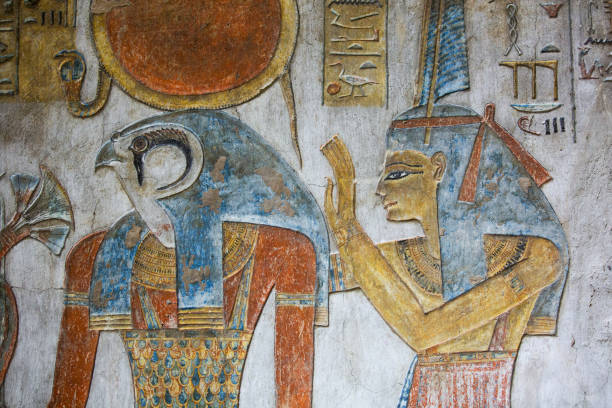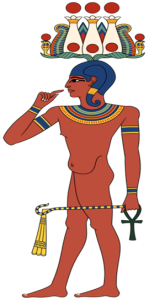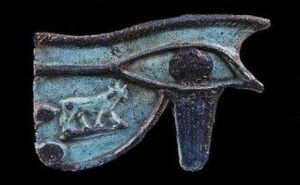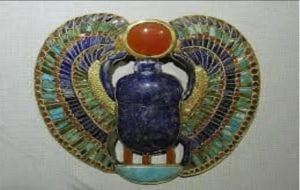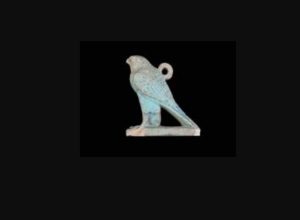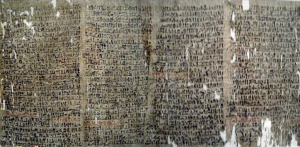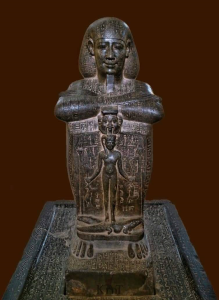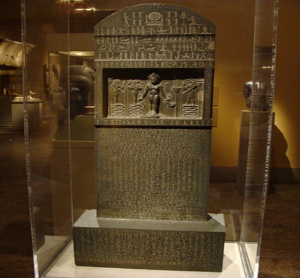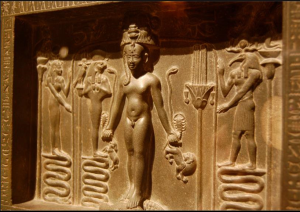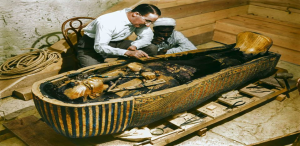Magic in Ancient Egypt
The sorcerer in ancient Egypt used magic in various forms. The god “Heka” was the god of magic for the ancient Egyptians.
Types of Magic
•Beneficial Magic: oAttracting a lover oHealing the sick •Harmful Magic: oSeparating couples oCausing problems between people
Times of Magic
Sorcerers were known to practice their magic, especially during the festivals of the goddess Hathor, the goddess of love and beauty, and this was done in her various temples. Young men and women would gather in the temples of the goddess and rush to obtain love amulets bearing the image of the goddess Hathor. The name of the beloved would be written on the amulets of the goddess.
Forms of Magic
Magic took many forms such as spells, talismans, amulets of various kinds, incantations, and charms. The sorcerer used wax dolls and puppets made of papyrus, drawing symbols and spells on them.
Placing the Magic Forms
Magic forms were placed in several places such as: 1.Above the doors of houses 2.Under the thresholds of doors or inside the rooms of the house 3.Under pillows 4.Places of daily life
Magic Amulets
There were many types of amulets among the ancient Egyptians, such as the Eye of Horus, the Djed pillar, the scarab, the Ankh sign, and the Was sign. There were also amulets of the god Horus due to his association with magic. -Eye of Horus Amulet
Scarab amulet of Khepri
Horus the Falcon Amulet
Papyri of Magic
Many papyri have been found that discuss magic. One of the most famous is: The Papyrus of Khufu and the Sorcerers The papyrus mentions that the son of King Khufu brought a sorcerer to his father. King Khufu asked the sorcerer to prove his magical abilities. The sorcerer cut off the neck of a goose and threw the goose in one direction and the neck in another. The sorcerer pointed at the neck of the goose and it rejoined the goose -Papyrus of Khufu and the Sorcerer” Westcar”
The Most Interesting Stories of Magic
A fascinating story tells of an Egyptian priest who discovered his wife’s infidelity with a young man. He created a small crocodile from wax and waited until the young man went down to the pool to bathe. The priest threw the wax crocodile into the pool and recited his magical incantation, transforming the wax crocodile into a real crocodile that attacked and killed his wife’s lover.
The Most Famous Magic Statue in the Egyptian Museum
statue of Djed hor This statue gained widespread fame due to rumors. It is known as the “Enchanted Statue.” Djed hor was an ancient Egyptian priest whose name means “the savior.” The statue depicts the priest sitting with a tablet in front of him showing the child Horus treading on two crocodiles, each facing in the opposite direction. Above Horus’s head is an image of the god Bes as a symbol of protection for the child Horus. The statue was used for therapeutic purposes, such as treating bites from snakes, scorpions, and venomous reptiles. The statue was carved from basalt and found in the city of Atrib in the Delta.
statue of Djed hor the most famous magical statue
Magical Tablets of Horus
The god Horus was associated with magic due to his mythical birth after the death of his father, the god Osiris. His mother, the goddess Isis, performed magic and conceived the god Horus. Horus can repel evil forces and overcome them. The tablets depict the god Horus naked. Horus is shown standing on crocodiles and holding snakes, scorpions, gazelles, and sometimes lions (all symbols of evil). The earliest date of the tablets dates back to the 18th Dynasty. The use of tablets became widespread in the Ptolemaic era. they contain inscriptions stating that the goddesses Isis and her son Horus were hiding, and the child Horus was bitten by a snake. The goddess Isis cried out for help in the “Boat of Eternity,” and the sun disk stood still and did not move, and darkness prevailed in the world. The god Thoth was sent to heal Horus and he was healed. Since then, Horus has been considered a symbol of healing. The tablets end with incantations and a phrase that says “and protection for the afflicted as well.” By using these inscriptions, any type of pain in humans could be healed. The energy of the statue and its symbols were dealt with using water, as the priests would pour water over the statue and let it flow and collect, then give the water to the patient to drink or bathe in. The tablets were placed in temples and homes to protect them from evil. There is a tablet in the Egyptian Museum and also in the Metropolitan Museum -Magical Tablets of Horus
The Curse of the Pharaohs
Lord Carnarvon, who funded Carter’s expedition that discovered the tomb of the Egyptian king Tutankhamun, was struck by the curse of an ancient Egyptian spell written in the tomb that says, “Whoever violates this tomb, I will swoop down on him like a bird on its prey.” He died. On the same night and thousands of miles away, the lord’s wife met the same fate when she was bitten by a mosquito. His private secretary, Richard Bethel, was found dead in a club bathroom. Arthur Mace also died while recording the contents of the king’s tomb. George Bendit also died after visiting the tomb, and Arthur S. Mays contracted an illness that killed him, as did Jay Gould.

